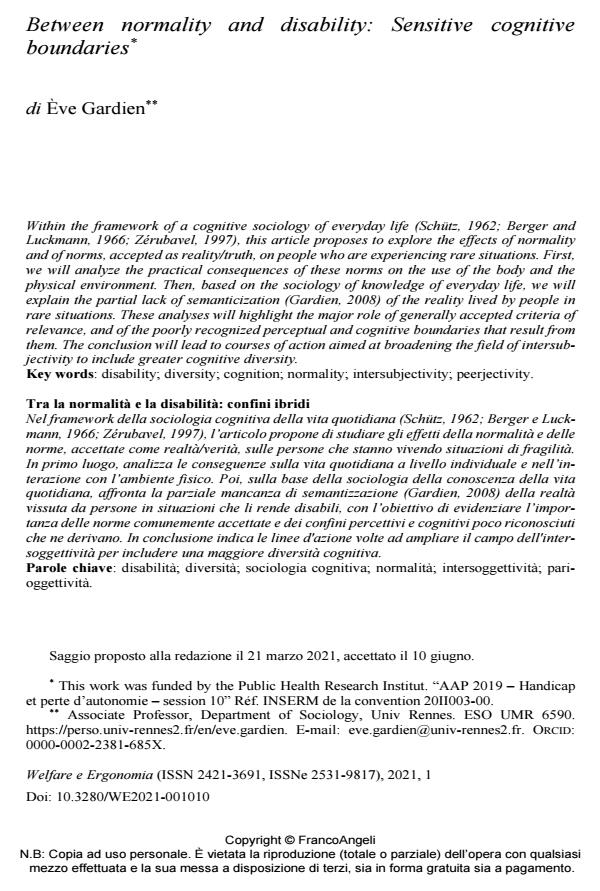Between normality and disability: Sensitive cognitive boundaries
Titolo Rivista WELFARE E ERGONOMIA
Autori/Curatori Ève Gardien
Anno di pubblicazione 2021 Fascicolo 2021/1
Lingua Inglese Numero pagine 13 P. 104-116 Dimensione file 273 KB
DOI 10.3280/WE2021-001010
Il DOI è il codice a barre della proprietà intellettuale: per saperne di più
clicca qui
Qui sotto puoi vedere in anteprima la prima pagina di questo articolo.
Se questo articolo ti interessa, lo puoi acquistare (e scaricare in formato pdf) seguendo le facili indicazioni per acquistare il download credit. Acquista Download Credits per scaricare questo Articolo in formato PDF

FrancoAngeli è membro della Publishers International Linking Association, Inc (PILA)associazione indipendente e non profit per facilitare (attraverso i servizi tecnologici implementati da CrossRef.org) l’accesso degli studiosi ai contenuti digitali nelle pubblicazioni professionali e scientifiche
Within the framework of a cognitive sociology of everyday life (Schütz, 1962; Berger and Luckmann, 1966; Zérubavel, 1997), this article proposes to explore the effects of normality and of norms, accepted as reality/truth, on people who are experiencing rare situations. First, we will analyze the practical consequences of these norms on the use of the body and the physical environment. Then, based on the sociology of knowledge of everyday life, we will ex-plain the partial lack of semanticization (Gardien, 2008) of the reality lived by people in rare situations. These analyses will highlight the major role of generally accepted criteria of rele-vance, and of the poorly recognized perceptual and cognitive boundaries that result from them. The conclusion will lead to courses of action aimed at broadening the field of intersub-jectivity to include greater cognitive diversity.
Nel framework della sociologia cognitiva della vita quotidiana (Schütz, 1962; Berger e Luck-mann, 1966; Zérubavel, 1997), l’articolo propone di studiare gli effetti della normalità e delle norme, accettate come realtà/verità, sulle persone che stanno vivendo situazioni di fragilità. In primo luogo, analizza le conseguenze sulla vita quotidiana a livello individuale e nell’interazione con l’ambiente fisico. Poi, sulla base della sociologia della conoscenza della vita quotidiana, affronta la parziale mancanza di semantizzazione (Gardien, 2008) della realtà vissuta da persone in situazioni che li rende disabili, con l’obiettivo di evidenziare l’importanza delle norme comunemente accettate e dei confini percettivi e cognitivi poco rico-nosciuti che ne derivano. In conclusione indica le linee d'azione volte ad ampliare il campo dell'intersoggettività per includere una maggiore diversità cognitiva.
Parole chiave:disabilità; diversità; sociologia cognitiva; normalità; intersoggettività; pari-oggettività.
- Travail des frontières dans l’intervention sociale Ève Gardien, pp.123 (ISBN:9791034609260)
Ève Gardien, Between normality and disability: Sensitive cognitive boundaries in "WELFARE E ERGONOMIA" 1/2021, pp 104-116, DOI: 10.3280/WE2021-001010